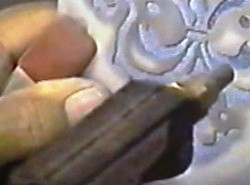Here are some basic steps to sandcarving glass with a two stage sandcarving method. It is just one way to etch glass. If you have read my ebook or read through the site, it discusses this as the major reason to use a pressure pot sandblaster.
Through a series of sandblasting stages, you can carve a 3 dimensional shape into the glass. This is very basic and can get more advanced.
So here are the basic steps to sandcarve glass with a sandblaster. It is a simple 2 stage sandcarving.
First, place your stencil on the glass and cut out the pattern with a knife by following the lines. This example is with a flower pattern by Ruth Webb Lee*. You will need to observe the stencil design. As you can see, I marked areas of the cut stencil with numbers. the number 1 means its the first blasting and the deepest to be carved. The number 2 means its the second blasting and is a light etch. Remove the number one areas of the stencil or the areas that would be closer to the observer when looking at. The picture below shows the first sandcarving stage ready to be blasted:

Below is a picture of the first stage deeply sandcarved with a pressure pot sandblaster:

After you have sandcarved the glass deep, then you can begin peeling back the stencil for the number 2 stage. Remember, you can mark the areas with a sharpe marker like I did. I marked the stencil areas with the number 2. As you can see, I pulled the areas and its ready to be lightly sandblasted below:

Then, for the final step after the second stage was lightly etched you can remove the stencil resist and clean up. Since I did a reverse etching which is the best way to sandcarve glass, you will need to flip the piece around as shown below:

If you liked this simple sandcarving, please bookmark this page with the buttons below. I will have more for you soon.
Update: Some people have been having problems with photo resists and stencils coming off so I made a post about fixing photoresist blowout problems. I hope these tips will help. Feedback would be great, just leave me a comment!
[nonmember]Summary:
Here is one of the first sandcarving step by step tutorials that I created. It explains a two stage sandcarving with a pattern from Ruth Webb Lee’s book.
Reference:
Lee, Ruth Webb. Ruth Webb Lee’s Handbook of Early American Pressed Glass Patterns. Framingham Centre, Mass.: R.W. Lee, 1936. Print.[/nonmember]
 This page just shows some videos that I collected which shows you an idea of how the PAB blaster works which can be made fairly easy with some mechanical skills in my instructions here:
This page just shows some videos that I collected which shows you an idea of how the PAB blaster works which can be made fairly easy with some mechanical skills in my instructions here: